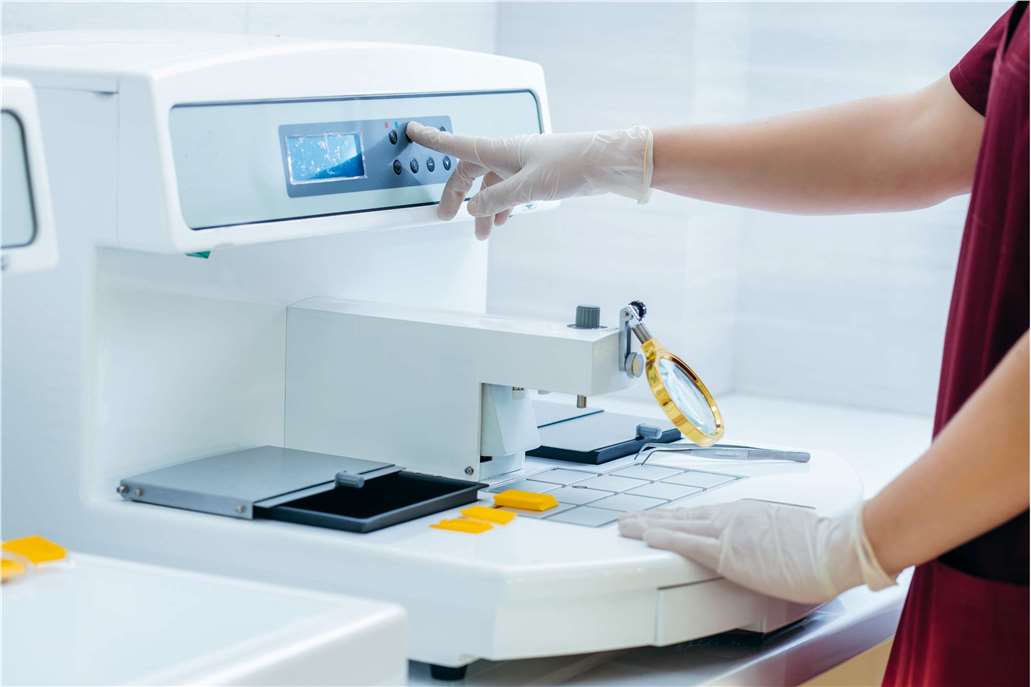Microscopic analysis of cells and tissues requires the preparation of very thin, high-quality sections (slices) mounted on glass slides and appropriately stained to reveal normal and abnormal structures.
Most fresh tissue is very delicate and easily distorted and damaged, so it is impossible to prepare thin sections from it unless it is chemically preserved or "fixed" and supported in some way whilst it is being cut.

What is Tissue Processing?
"Tissue processing" describes the steps required to take animal or human tissue from fixation to the state where it is completely infiltrated with appropriate histological paraffin and can be embedded ready for section cutting on a microtome.
Overview of the Steps in Tissue Processing for Paraffin Sections
Fixation
Fixation is the foundation for the preparation of tissue sections. The purpose of fixation is to permanently preserve the tissues in as life-like a state as possible. First, the process of autolysis and bacterial attack should be prevented. Second, tissues should not change shape or volume, and they should be left in a condition that subsequently allows for clear staining. At the same time, the tissue should be as close to its living state as possible without loss or rearrangement.
Dehydration
Because melted paraffin wax is hydrophobic (immiscible with water), most of the water in tissue must be removed before it can be infiltrated by the paraffin. This process is usually performed by immersing the tissue in a series of ethanol (alcohol) solutions of increasing concentration until pure, water-free alcohol is reached. Ethanol is miscible with water in all proportions so that the water in tissue is progressively replaced by alcohol. A series of increasing concentrations is used to avoid excessive distortion of the tissue.
Clearing
Clearing is a transitional step between dehydration and infiltration with the embedding medium. Although the tissue is essentially water-free following dehydration, infiltration with paraffin cannot be carried out because wax and ethanol are largely immiscible. We, therefore, have to use an intermediate solvent that is completely miscible with both ethanol and paraffin. This solvent will displace ethanol in the tissue, which is then displaced by molten paraffin. This stage of the process is called "clearing". Another important role of the clearing is to remove large amounts of fat from the tissue, which would otherwise present a barrier to paraffin infiltration.
Infiltration
The tissue can now be infiltrated with a suitable histological reagent. Although many different reagents have been evaluated and used for this purpose over the years, paraffin wax is the most popular. During this process, clearing agent diffuses out and molten paraffin is infiltrated. Routinely two changes are given to the paraffin to get proper impregnation.
Embedding
Paraffin embedding is a standard method used in histology laboratory to produce blocks of tissue for section cutting (microtomy). This process, usually carried out using an embedding center, involves surrounding the tissue by a medium such as paraffin wax, which when cooled and solidified, will provide sufficient support for section cutting or microtomy.
Decalcification
Some tissues contain calcium deposits that are too firm to section properly with paraffin embedding due to the density difference between calcium and paraffin. This calcium must be removed prior to embedding for sectioning. A variety of agents or techniques have been used to decalcify tissue. Strong mineral acids, such as nitric and hydrochloric acids are used in dense cortical bone because they remove large quantities of calcium at a rapid rate. Organic acids, such as acetic and formic acid, are better for bone marrow, since they are not as harsh. Formic acid in a 10% concentration is the best all-around decalcifier. Some commercial solutions that combine formic acid with formalin are available to fix and decalcify tissues at the same time. EDTA can remove calcium and is not harsh, but it penetrates tissue poorly and works slowly and is expensive in large amounts.